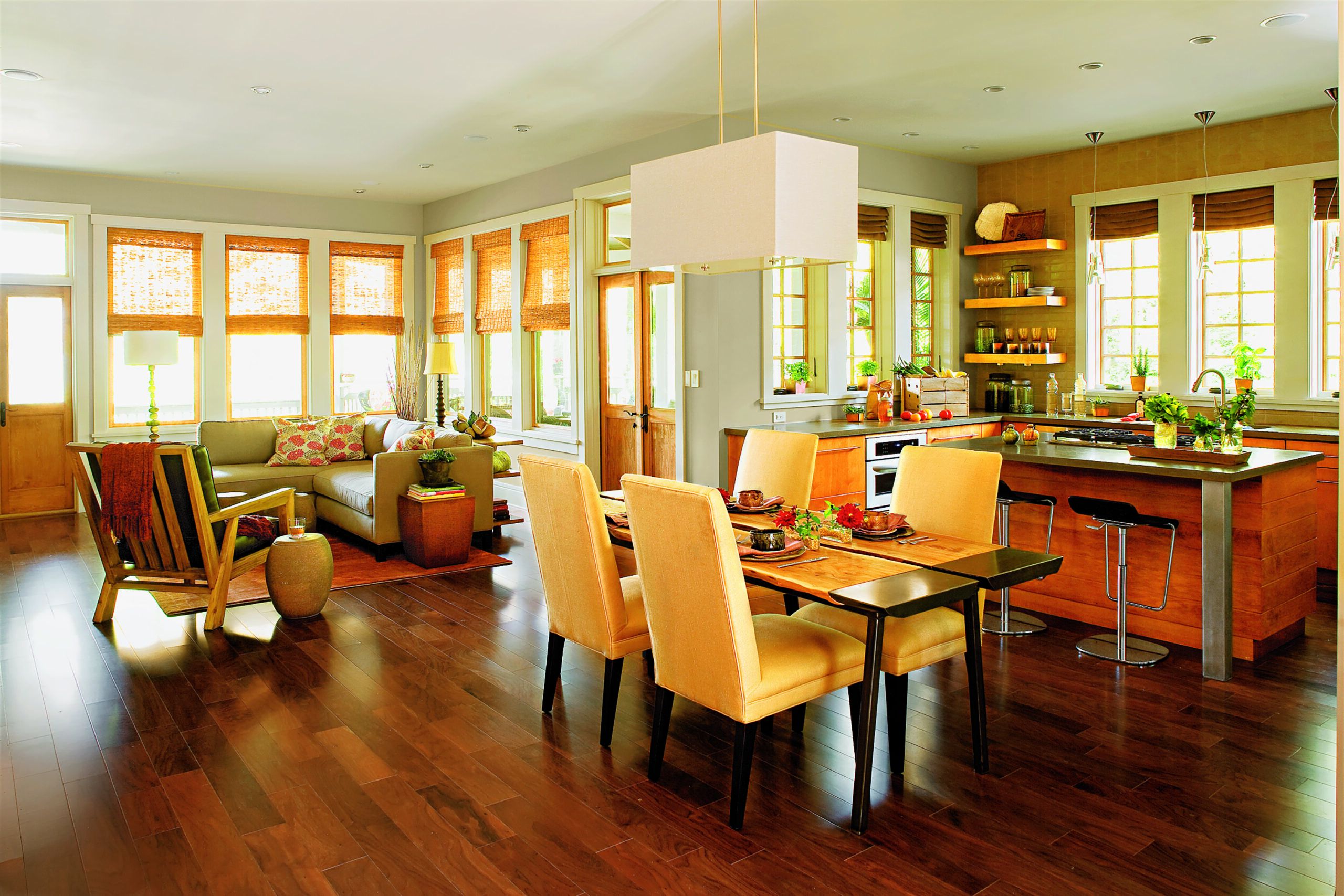Hardwood floors are always in fashion, and they can add to the resale value of your home. Whether you’re laying a wood floor in a new house or replacing one that’s damaged beyond repair, you can tailor your floors to your house’s style and decor.
Below, we’ll answer some common questions homeowners have about hardwood floors and offer tips for buying and installing these materials. We’ll also list some of the most commonly used hardwoods and provide pictures to inspire your designs.
Hardwood Flooring Facts
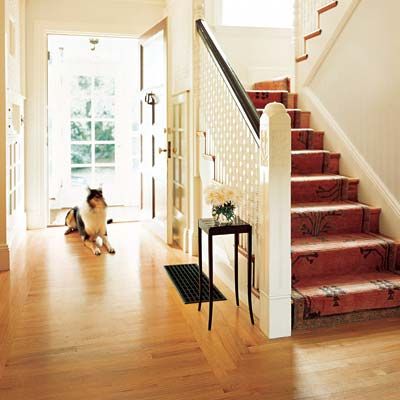
How Much Do Hardwood Floors Cost?
Material costs are between $4 and $15* per square foot depending on wood thickness, species, and grade. Some prefinished solid-wood and engineered wood floors may be appropriate projects for experienced DIYers, but if you plan to hire a pro installer, the total hardwood flooring cost is typically between $6 and $25 per square foot.
*Cost data in this section sourced from contractor estimates used by Angi.
How Many Years Do Hardwood Floors Last?
Some prefinished solid-wood boards come with a 50-year warranty. With regular care, though, any solid-wood floor can last twice that long. Warranties on the finish for engineered wood range from 10–30 years, since they can only be refinished once or twice. However, note that most warranties require professional installation.
How Do You Maintain Hardwood Floors?
Sweep, dry mop, or vacuum hard floors regularly and lay runners and doormats near entries. Polish the flooring two to four times a year, and refinish solid wood every seven to 10 years as necessary.
Where Do You Install Hardwood Floors?
You can install hardwood flooring just about anywhere, except in areas prone to extreme humidity and standing water. This means solid hardwood isn’t the best choice for bathrooms, basements, and laundry rooms.
Hardwood Floor Buying Tips
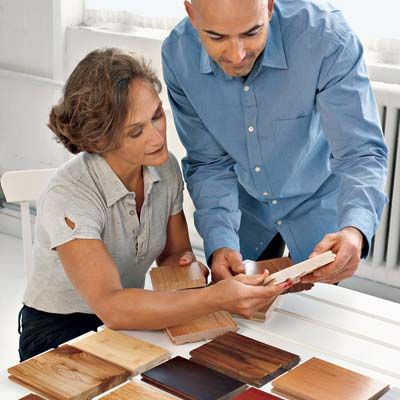
Ask yourself these questions to narrow your search for the right wood floor.
Where Do You Plan To Use It?
Consider how much moisture and traffic the floor will need to withstand.
- Kitchen and entryway: Choose a hard wood, such as oak or hickory, which can handle heavy foot traffic better than a soft pine.
- Bedroom and home office: Rooms off the beaten path are good locations for softer woods, such as black cherry or black walnut.
- Basement: Avoid using solid-wood flooring below grade, where high humidity prevails. An engineered wood floor is a better option here because it’s more stable.
- Bathroom: Water can warp wood, making it a poor choice for baths with tubs and showers.
What’s Your Hardwood Floor Going Over?
The existing floor or subfloor will determine how your new wood flooring can be installed.
- Plywood subfloor: As long as it’s solid and flat, you can install any type of nail- or glue-down hardwood, as well as click-together engineered strip or cork plank floating floors.
- Existing wood floor: Thinner boards with long-wearing factory-applied finishes are better here to ensure safe, no-trip transitions to adjacent rooms, hallways, and stairways.
- Concrete slab or tile: Nails aren’t an option. Consider a click-together floating floor or one that can be glued down.
- Radiant floor: Engineered flooring is ideal because it’s thinner and more stable than most solid wood.
Hardwood Flooring Costs
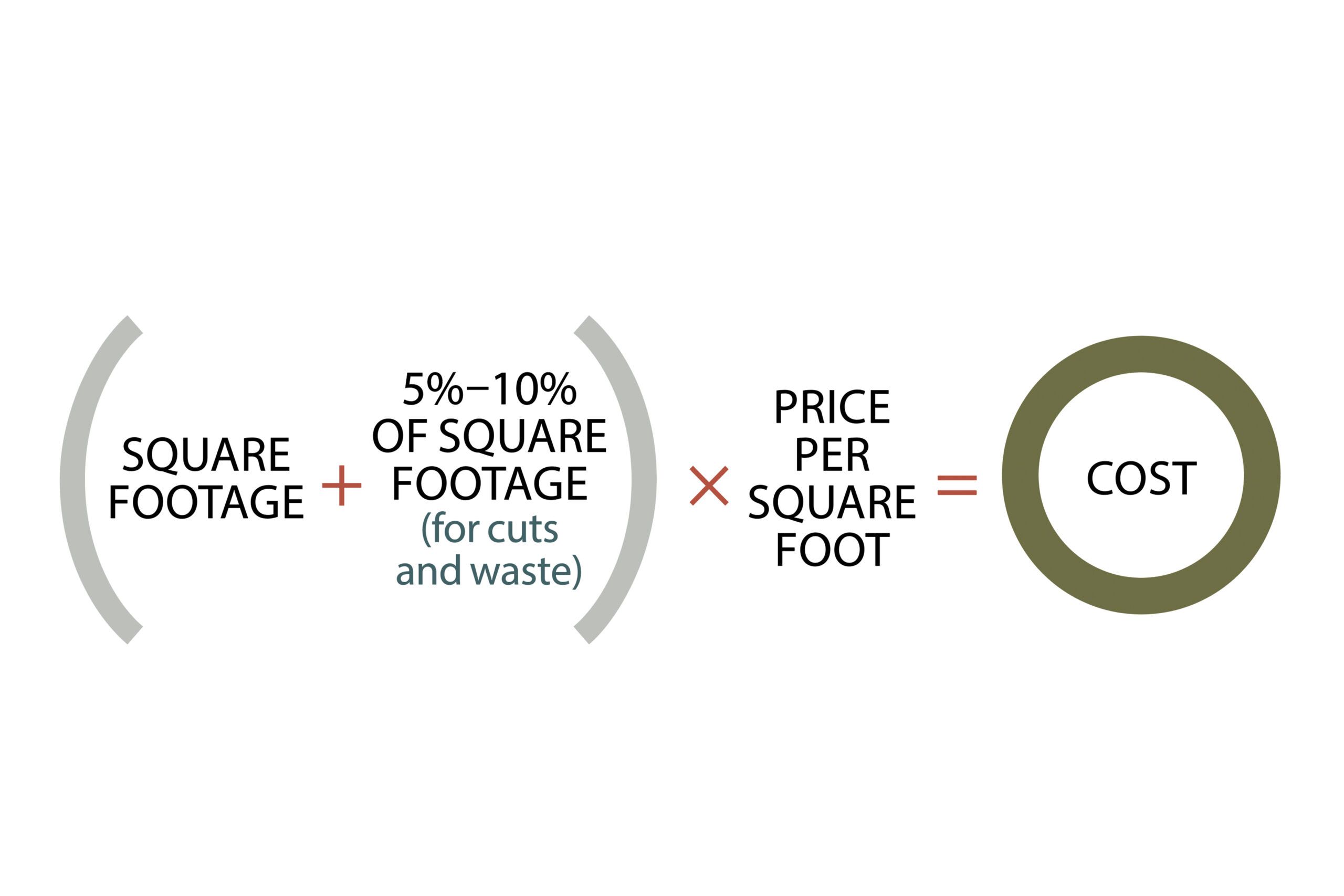
To figure out how much your floor will cost, calculate the room’s square footage, then add 5%–10% for cuts and waste. Multiply this figure by the board’s square-foot price to get your cost. Don’t forget to add on a few extra bucks for door thresholds, shoe moldings, and any nails or staples you might need.
Hardwood Floor Basics
Even if you’ve determined solid hardwood is the best option for your home, you’ve still got a few more choices to make. In addition to the appearance of the wood, here are some qualities to keep in mind.
- Thickness: Solid 3/4-inch boards can be refinished up to 10 times. Thinner ones can’t be sanded as much, but when topped with durable factory-applied coatings, they shouldn’t require frequent refinishing.
- Length: Longer boards mean fewer distracting end joints and easier installation. But to make a small room appear bigger, use shorter strips.
- Width: 6-inch planks have a rustic appeal, but large-width boards are more costly and the joints open wide during dry weather. Alternatively, 2 1/4-inch strips look busier but stay tighter. Mix widths for the best of both.
- Hardness: The harder the wood, the less prone it is to dents and gouges. The graphic below shows how various species stack up. In general, cherry and pines are some of the softest woods, oak and walnut are in the middle, and exotic hardwoods top the scale.
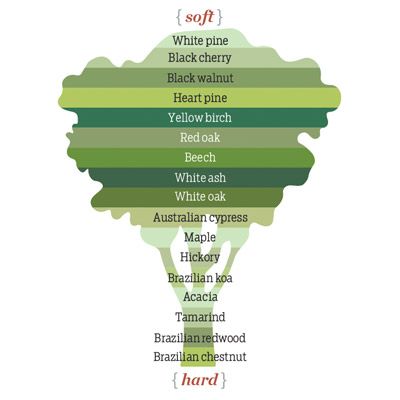
Hardwood Cuts
- Flatsawn boards are cut so that the growth rings are roughly parallel with the face, leaving a distinctive flamelike grain pattern.
- Quartersawn boards, which are more expensive, have a straight grain and growth rings perpendicular to the face.
Hardwood Grading
Mills sort each piece of flooring into different grades depending on the number of defects, such as knots and color variations. The fewer the defects, the more costly the wood. Just remember that the definition of defect changes from species to species. For example, knots are nonexistent in the best grade of maple and plentiful in the same grade of Australian cypress. Wood defects aren’t necessarily bad—when purchased from a reputable mill, the boards are every bit as strong as wood without defects, and they create a more rustic, cozy appearance.
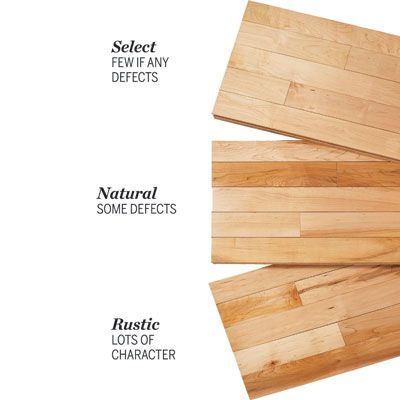
Prefinished vs. Site-Finished Hardwood Floors
All hardwood floors eventually need to be finished to protect and seal the wood, but you can buy the boards either prefinished at the factory or have them installed and finished onsite. Finishes packed with aluminum oxides and cured under UV lights in a factory are tougher than ones applied on-site. You can walk on the floor the day it’s installed, since there’s no sanding or waiting for coats to dry. However, every edge has a slight bevel at the joint, something you won’t see on a site-finished floor.
Unfinished boards offer more customization in terms of color and staining. They’re cheaper to buy but more expensive and time-consuming to install, and you’ll have to allow time for the toxic fumes to air out.
What Are the Types of Hardwood Floors?
Below, we’ll highlight some common wood flooring options, including specific details and pictures. These options are broken down into classic domestic wood, exotic wood, distressed wood, engineered wood, and wood-like alternatives.
Classic Wood
Domestic woods come in a variety of colors, grain patterns, and hardnesses.
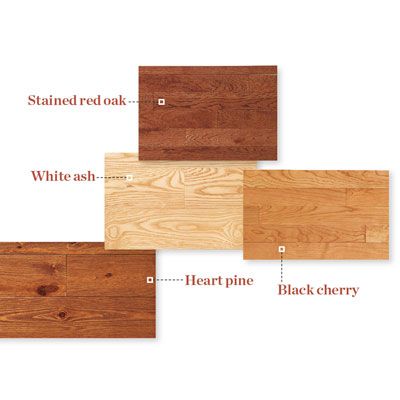
- Stained red oak
Price: $8–$13 per square foot*
Highlight: It’s the most common wood-strip flooring in American homes.
- White ash
Price: $9–$11 per square foot
Highlight: This blond wood has a prominent grain pattern.
- Black cherry
Price: $4.30–$30 per square foot
Highlight: Under a clear finish, its natural cinnamon tint darkens with age.
- Heart pine
Price: $4.50–$13 per square foot
Highlight: Rusty-hued and knotty, it’s been in Southern homes since colonial times.
Exotic Wood
Woods from the tropics are renowned for their rich colors and extreme hardness.

- Brazilian redwood
Highlight: The deep russet color and subtle grain won’t distract from a room’s decor.
Price: $11–$20 per square foot
- Australian cypress
Price: $3.85–$5.75 per square foot
Highlight: Its distinct grain and profusion of knots give any room a rustic look.
- Black acacia
Price: $2.90–2.90 per square foot
Highlight: This stained hardwood has a golden tone when topped just with a clear finish.
- Brazilian koa
Price: $5–$7 per square foot
Highlight: Dark chocolate and blond stripes alternate in an eye-catching combination.
Distressed Wood

Flooring with an aged look, from day one.
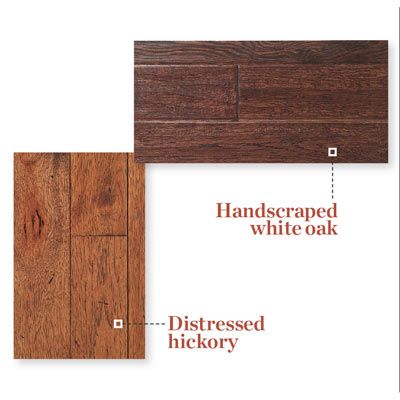
- Distressed hickory
Price: $6–$13 square foot
Highlight: Dented with chains, then stained to a rich hue.
- Handscraped white oak
Price: $8–$15 per square foot
Highlight: Random ripples are carved along the length of each strip.
Bamboo
Although not technically wood, bamboo flooring makes for a sustainable, lightweight alternative to hardwood. It tends to cost between $5 and $11 per square foot and comes in several variations.
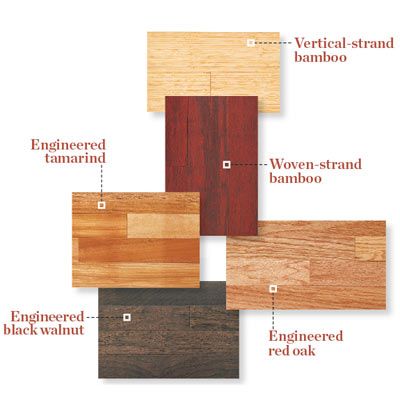
- Vertical-strand bamboo
Highlight: This grass, which reaches maturity in about six years, is an eco-friendly alternative to slow-growing trees.
- Woven-strand bamboo
Highlight: Weaving the strips together creates a flooring as hard as hickory.
Engineered Wood (DIY Floors)
The base is plywood, its top is a prefinished wood veneer. Strips can be fastened or glued down, or left to float. Prices range from $4.50–$16 per square foot based on the type of wood and quality of the flooring as a whole.
- Engineered tamarind
Highlight: Get the look of teak for about the same price as bamboo.
- Engineered black walnut
Highlight: This naturally dark wood has been popular since Victorian times.
- Engineered red oak
Highlight: A classic, tough hardwood, just 3⁄8 inch thick.
Cork (DIY Floors)
Made from the bark of cork oak trees in Spain and Portugal, this click-together or glue-down flooring is soft underfoot, a natural insulator, and an excellent sound absorber.
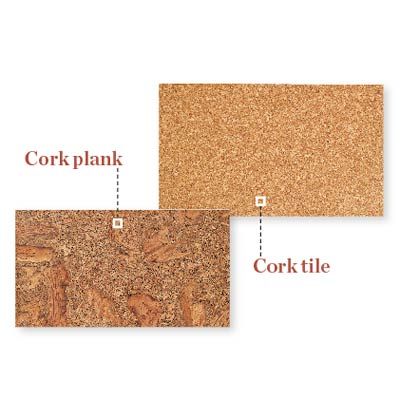
Price: $4–$8 per square foot
Highlight: These 11-milimeter-thick planks snap together and float over the subfloor.
- Cork tile
Price: $3–$7 per square foot
Highlight: Only 5/32 inch thick, this cork-crumb amalgam is glued directly to the subfloor.
Laminate (DIY Floors)
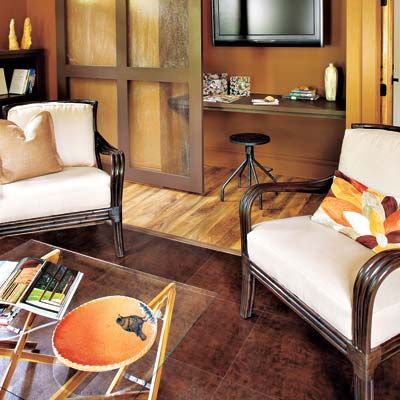
If you want the look of wood without the high price tag, laminate flooring is a photo of wood, glued to a fiberboard substrate. These wide planks are a snap to install—literally—but once they’re worn, they can’t be refinished.
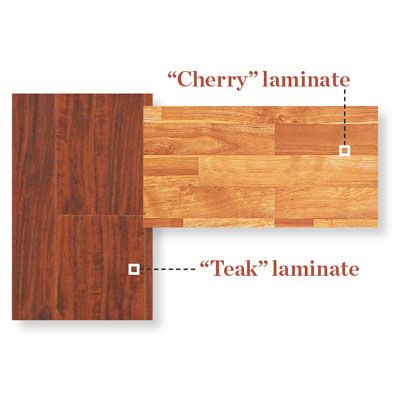
- Cherry laminate
Price: $1 per square foot
Highlight: These 1/4-inch-thick pieces click together.
- Teak laminate
Highlight: Its undulating surface resembles a handscraped wood floor.
*Cost data in this section sourced from contractor estimates used by HomeAdvisor.
Hardwood Floor Styles
Get inspiration for your next project with our visual guide to floor styles.
Bamboo
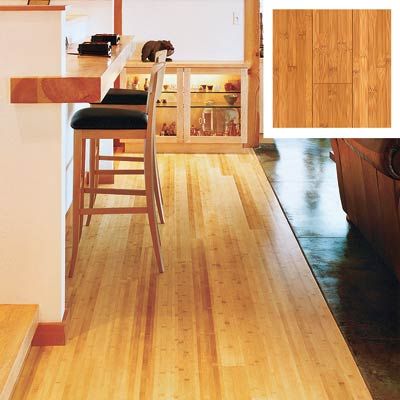
This green flooring from Southeast Asia has a bright contemporary feel. Carbonized 3 3/4-inch horizontal planks, similar to shown, cost about $7–$20 per square foot.
White Pine
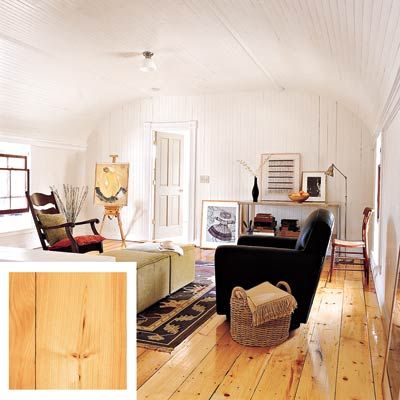
Wide, knotty planks complement the rustic beadboard wall and ceiling paneling. Unfinished 8 7/8-inch planks, similar to shown, cost about $4.50–$10 per square foot.
Distressed Heart Pine
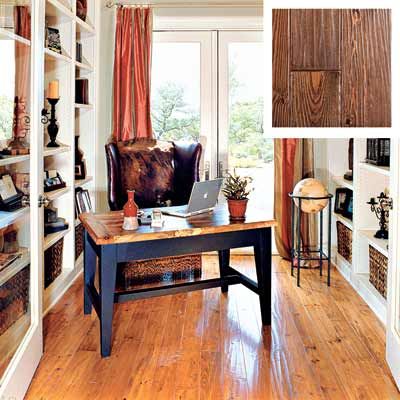
Handscraped flooring adds character and patina to any room. Five-inch strips, similar to what’s shown, are about $4.50–$10 per square foot.
Cork
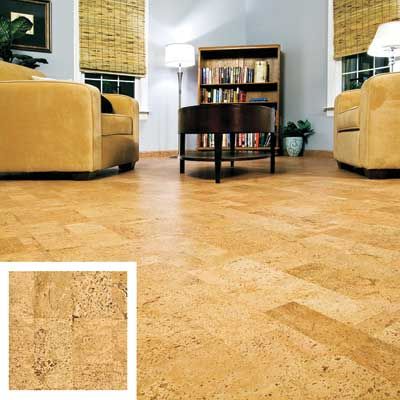
In a family room or den, this floating floor reduces noise and cushions footfalls. Twelve-inch-wide click-together planks, similar to shown, cost about $4–$8 per square foot.
Engineered Beech

Dark-stained wood makes this small home office feel larger. Engineered 4 1/4-inch strips that are similar to what’s shown cost about $4.50–$16 per square foot.
Brazilian Chestnut
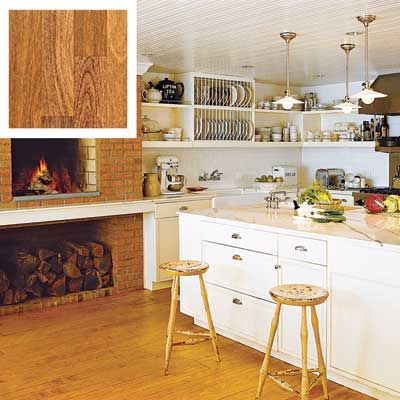
This dense exotic stands up nicely to traffic in busy kitchens.
Finishing Options
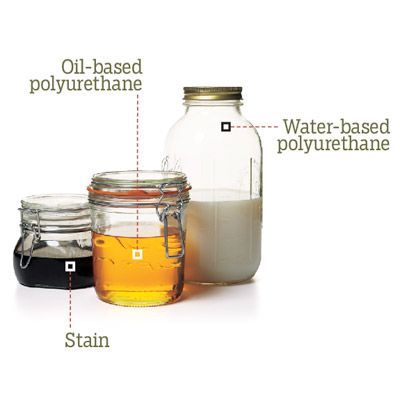
If you’re choosing your own finish, here’s what to know about the different types:
- Oil-based polyurethane: Long the gold standard for durability, it imparts an amber hue to wood. Wait 24 hours between coats and allow three days to cure.
- Water-based polyurethane: Goes on milky but quickly dries to form a crystal-clear finish. Two coats can be applied in one day, then give it three days to cure. It has virtually no odor.
- Stain: Uses penetrating pigments to darken wood color and enhance its grain. Apply before the protective finish coats.
Our Conclusion
Hardwood flooring is a substantial financial investment, but it can last for decades when properly maintained and keep its value just as long. Choose your flooring carefully, considering not just appearance but also strength and ease of installation. We strongly recommend hiring a professional to install your hardwood or engineered wood floor, which will help ensure its look and durability for years to come.
